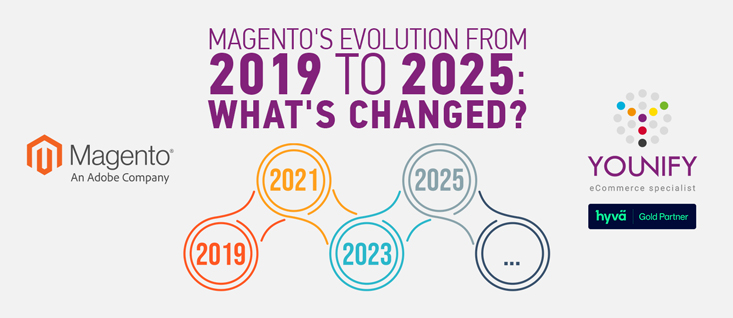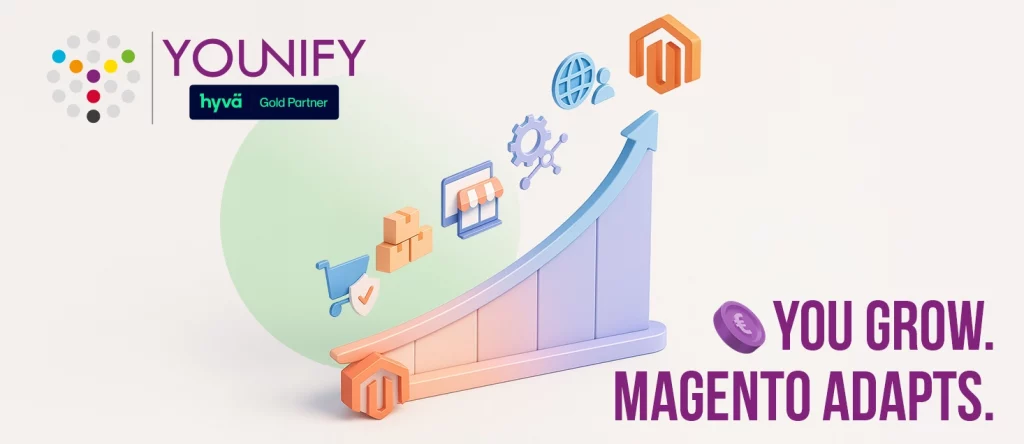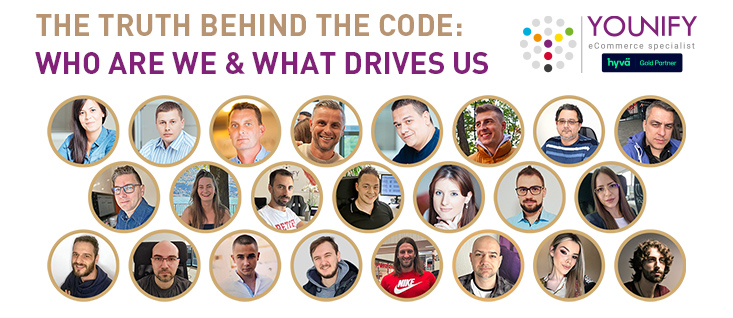Magento in 2019: A Snapshot
In 2019, Magento 2.1 was already a mature platform, offering advanced features like multi-store management, extensive customisation options, and a rich ecosystem of extensions. However, it wasn’t without its challenges. Many merchants found the platform complex and resource-intensive, requiring skilled developers for even minor customisations. Performance issues, particularly slow page load times, were also common complaints. Despite these problems, Magento maintained a strong market position, especially among enterprise-level clients who valued its scalability and flexibility. Competitors like Shopify and WooCommerce were gaining traction, but Magento’s ability to handle large-scale operations kept it ahead.
Major Milestones and Updates (2019–2025)
The period from 2019 to 2025 marked a transformative era for Magento. One of the most significant events was Adobe’s acquisition of Magento in 2018, which began to bear fruit in the following years. This acquisition led to tighter integration with Adobe’s suite of tools, including Adobe Experience Manager and Adobe Analytics, enhancing Magento’s personalisation and data-driven decision-making capabilities. Another groundbreaking development came in 2020 with the introduction of the Hyvä theme. Hyvä is a lightweight frontend explicitly designed for Magento that addresses many performance issues associated with traditional Magento themes. Built using modern technologies like Tailwind CSS and Alpine.js, Hyvä offers faster page load times, improved SEO, and a simplified development process. Over 15% of Magento 2 stores adopted the Hyvä theme soon after their launch, and this number continues to grow as merchants recognise its potential to enhance both user experience and operational efficiency.
Other notable updates during this period include:
- The shift toward cloud-based solutions, such as Adobe Commerce Cloud, has streamlined deployment and maintenance.
- Improved focus on headless commerce and API-first architecture, allowing merchants to deliver seamless omnichannel experiences.
- Continuous improvements in security and compliance standards, ensuring Magento remains a trusted choice for global enterprises.
Technological Advancements
From 2019 to 2025, Magento embraced several technological advancements that solidified its position as a leader in eCommerce innovation. The adoption of GraphQL enabled developers to create more efficient APIs, reducing server load and improving response times. Similarly, Progressive Web App (PWA) Studio empowered merchants to build app-like experiences directly within their websites, boosting engagement and conversion rates. AI and machine learning also became integral parts of Magento’s offerings. These technologies allowed merchants to deliver hyper-personalised shopping experiences, optimise inventory management, and gain deeper insights into customer behaviour.
Additionally, the rise of omnichannel retailing meant that Magento now supports easy integration across multiple sales channels, including brick-and-mortar stores, social media platforms, and mobile apps. The Hyvä theme played again a crucial role in accelerating Magento’s technological evolution. By leveraging proven, future-ready tools, Hyvä simplifies the development process and ensures that Magento stores remain performant and scalable. Its modular approach allows developers to implement changes quickly, reducing time-to-market for new features and updates.
User Experience and Developer Ecosystem
Improvements in user experience were another moment in Magento’s evolution. The admin panel became more intuitive, making it easier for non-technical users to manage their stores. Documentation and learning resources have also been significantly enhanced, empowering developers to master the platform more effectively. The developer ecosystem flourished during this period, partly thanks to innovations like the Hyvä theme. Developers appreciated its rich functionality and toolkit, which included a range of extensions and comprehensive support. For merchants, this translated into faster development timelines and higher-quality results. Moreover, Hyvä’s emphasis on accessibility and SEO helped stores rank better in search engine results, driving organic traffic and increasing revenue.
Market Trends and Competitive Landscape
Magento adapted remarkably well to shifting market trends. The rise of mobile and social commerce prompted the platform to prioritise mobile optimisation and social media integrations. While competitors like Shopify Plus and BigCommerce gained ground, Magento retained its appeal among enterprise clients due to its scalability and customisation options. One area where Magento truly shone was its ability to serve both large corporations and small-to-medium businesses (SMBs) well. Affordable pricing models and flexible licensing options made it accessible to a broader audience. Meanwhile, the Hyvä theme further levelled the playing field by enabling SMBs to achieve enterprise-grade performance without breaking the bank.
Challenges Faced Along the Way
Despite its successes, Magento faced several challenges during this period. Balancing its open-source roots with proprietary offerings proved difficult, leading to concerns about accessibility and cost. Additionally, the platform’s complexity remained a barrier for some merchants, particularly those without dedicated IT teams. However, initiatives like the Hyvä theme helped mitigate these issues by providing a simpler, more cost-effective alternative to traditional Magento setups. Ongoing efforts to improve documentation and community support also addressed many of the pain points experienced by users and developers alike.
The Future Outlook (2025 and Beyond)
Looking ahead, Magento’s future appears bright. The continued growth of the Hyvä theme suggests that performance and scalability will remain top priorities for the platform. With over 15% of Magento 2 stores already adopting Hyvä, its influence is undeniable. Merchants can expect even more innovative features and tools to emerge, further enhancing the platform’s capabilities. Global expansion and niche markets present exciting opportunities for Magento. As companies increasingly focus on sustainability and localisation, Magento’s flexibility will enable merchants to tailor their offerings to diverse audiences. Furthermore, advancements in AI agents and headless commerce will likely drive greater personalisation and efficiency, ensuring Magento stays ahead.
Conclusion
From 2019 to 2025, Magento underwent a remarkable transformation, evolving into a more powerful, user-friendly, and innovative platform. Key developments like the Hyvä theme revolutionised the Magento landscape, addressing longstanding performance issues and setting new standards for excellence.
Need Assistance?
If you want to leverage these advancements and take your Magento store to the next level, Younify is here to help. Our team specialises in Magento development, Hyvä implementation, and providing tailored solutions to meet your business needs.
Contact us today to explore how we can support your e-commerce goals.





